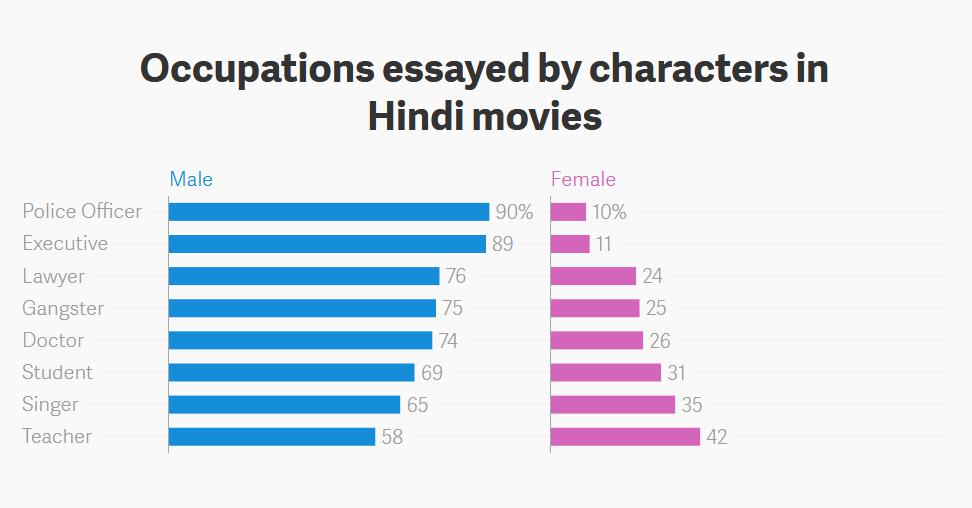Bollywood movies are crazy sexist
Bollywood has been notorious for its mistreatment of woman characters—and now data proves it.
Over the years, women portraying central characters in Hindi cinema have been few and far between. Those portrayed, including the protagonists, are rarely holistic and mostly subject to ingrained biases. “Different features like occupation, introduction of cast in text, associated actions, and descriptions are captured to show the pervasiveness of gender bias and stereotype in movies,” a recent analysis of Bollywood movies by IBM and two Delhi-based institutions revealed.
To study such disparities, researchers used an IBM dataset of Wikipedia pages of 4,000 Hindi movies released between 1970 and 2017, extracting titles, cast information, plots, soundtracks, and posters. They also analysed 880 official trailers of movies released between 2008 and 2017.
The on-screen gap
Over the nearly 50 year period, males are mentioned on average 30 times per plot on Wikipedia compared to female cast members, who are mentioned only 15 times. This suggests that an actress’s role is not given as much importance as the actor’s, according to the researchers.
Woman characters are mostly described with surface-level qualities—attractive, beautiful—whereas men are represented as “strong” and “successful” associated with them. “…verbs like ‘kills’ and ‘shoots’ occur with males while verbs like ‘marries’ and ‘loves’ are associated with females,” the researchers noted.
In trailers, women are shown to be much happier and less angry than men. This representation is in line with research from 2012 which found that commercial Hindi films portray “ideal women” as submissive, self-sacrificing, chaste, and controlled, while the “bad” woman is “individualistic, sexually aggressive, westernised, and not sacrificing.”
The data also revealed that during introduction sequences, descriptors for males are profession-driven whereas women are associated with physical appearances, emotional states, or their relation to a male, such as the “wife of” or “daughter of” so-and-so.
In most storylines, males had superior occupations: Over 32% of male characters were doctors, compared to just 3% of women; for female characters, the most popular careers were teachers or secretaries. Roles of lawyers, CEOs, and police officers were overwhelmingly played by male actors.

Despite trivialising their roles, filmmakers don’t hesitate to use women as bait in luring audiences to theatres.
“While 80% of the movie plots have more male mentions than females, surprisingly more than 50% movie posters feature actresses,” the researchers noted, citing examples of movies like GangaaJal and Raees. In these movies, the males have more than 100 mentions in the plot and females have none, yet the posters feature females “very prominently.”
“They want to publicise through (the actress) but when it comes to actual story, she has been sidelined,” said Nishtha Madaan of IBM India. Madaan co-wrote the paper with Sameep Mehta of IBM and researchers from the Indraprastha Institute of Information Technology, Delhi, and Delhi Technological University.
Off-screen woes
Meanwhile, the lack of attention paid towards women extends beyond actresses, too.
A soundtrack analysis of film songs released since 2010 showed that women sing consistently fewer songs than men—a trend that leading female vocalists have spoken out about. “If one takes into account the actual part of the song sung, this trend will be even more dismal,” the researchers said.
Women are also mostly missing in areas like production, direction, and cinematography.
Changing roles
Madaan acknowledges that while this stereotyping is a reflection of “how people think,” it is also a testament to “how the thinking is changing.” With many mainstream actresses like Anushka Sharma of NH10 fame and Kangana Ranaut and Vidya Balan, who opted for female-centric scripts like Queen and Kahaani respectively, things are changing on-screen.
The proportion of female-centric movies has risen in recent years. “Our system discovered at least 30 movies in last three years where females play central role in plot as well as in posters,” the study said, referring to movies like Neerja, Nil Battey Sannata, Margarita with a Straw, Dear Zindagi, Akira, and more.
Between 2015 and 2017, females were the central characters in 11.9% of Hindi movies released between 2015 and 2017. Back in the 70s, this figure was closer to 7%.
Content Source: Quartz India

3 Replies to “Bollywood movies are crazy sexist”
me and my wife were looking for this , thanks !
you are welcome, john
such a nice collection…..